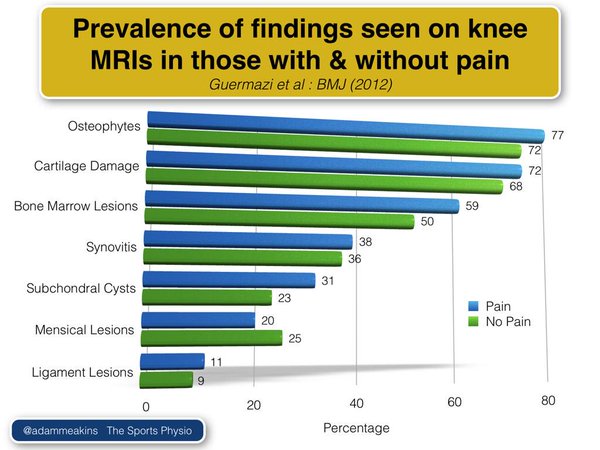Seeing is believing. It can be also expressed as "only physical or concrete evidence is convincing" which you surely have heard as a popular argument on many fronts.
Well, your patients are human, and thus, adding physical evidence to your statements or positions can aid in understanding and spur conversation.
Dr. Spencer Muro ( @SpencerMuro ) suggested that, when educating pt's on pain science or imaging results, we use the above concept to corroborate our "claims." Use visible evidence, not just repeat it verbally. Enter: The Patient Education Binder.
We used to show patient's pictures of these images on our phones, but a print-our hard copy in large font is more useful and meaningful (personal anecdote). Now, we did not make these images, and I will give credit to the maker's / authors of them. I asked The Sports Physio ( @AdamMeakins ) to tweet some of them, PainCloud.com ( @PainCloud1 ) produces great stuff, the rest are found on Twitter or a search engine. Disclaimer disclaimer etc. (Most credit is available on the image itself). They are great representations of current understanding.
If they help us understand, why not share with your patient?

The above is from: http://www.ncbi.nlm.nih.gov/pubmed/24308922

The above is from: http://www.ncbi.nlm.nih.gov/pubmed/25430861

The above is from: http://www.ncbi.nlm.nih.gov/pubmed/25430861

The above is from: Adam Meakins and http://journals.lww.com/spinejournal/Abstract/2015/03150/Abnormal_Findings_on_Magnetic_Resonance_Images_of.11.aspx

The above is from Adam Meakins and http://www.bmj.com/content/345/bmj.e5339

The above is from Adam Meakins and http://www.ncbi.nlm.nih.gov/pubmed/21940544

The above is from Adam Meakins and http://www.ncbi.nlm.nih.gov/pubmed/25009200

The above is from PainCloud. A great tool in discussing the multiple aspects that affect a person's sensation.

The above is from PainCloud. Great for explaining about sensitivity.

The above is from http://bjsm.bmj.com/content/early/2015/05/15/bjsports-2014-094386.abstract on patellar tendinopathy. (helpful in getting people to buy in to "just squeezing muscles?!")

I don't know where the above is from. I first saw it on Matthew Danziger's blog A Primer On Pain in 2013. (Yes, it's not me, we have a similar name... really crazy.) Moving past that doppelganger name bit, here is a link to the content: http://www.ncbi.nlm.nih.gov/pubmed/12909433

The above is from Adam Meakins. Good to add a little humor in to the process. Also, you physicists will notice: this recovery plan involves time travel, which is exciting.

The above is from Dr. Rod Henderson and Adam Meakins.

The above is from https://physsportsmed.org/doi/10.3810/psm.2011.09.1933 or here. This picture is rather motivating, can bust some myths about age and inspire chronic exercise.
Spencer also adds a Pain Video Handout to patients that it is appropriate for. This is good for "Video Homework" and is a great way to share ideas. Good opportunity to ask questions of the patient on the return visit about the content.
Here is what he shares:
Pain Education Videos
- Go to www.youtube.com
- Four video’s to watch (by title):
- “Understanding Pain in less than five minutes.”
- Time-lapse illustration video explaining pain and our current understanding of it, without technical jargon. (see it here)
- “Placebo: Cracking the code.”
- Just watch the first segment (~8 mins long), discusses some “sham” or placebo research done with knee arthroscopic surgeries for knee pain. (see it here)
- “This Video Will Hurt”
- Another animated, slightly humorous video discussing research surrounding the opposite of the placebo, the nocebo. (see it here)
- “Why things Hurt”
- Australian pain science researcher and physiotherapist, Lorimer Moseley, explains how pain is a construct of the brain. (see it here)
I hope this was helpful. Get out there and engage that population!
An image is a powerful thing. Use the power for good.
-Matt Dancigers, DPT
Interested in live cases where I apply this approach and integrate it with pain science, manual therapy, repeated motions, IASTM, with emphasis on patient education? Check out Modern Manual Therapy!
Keeping it Eclectic...
















Post a Comment
Post a Comment